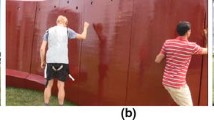Abstract
The present study investigates the affordance of vibrotactile signals in a simulated haunted house. Participants experienced a virtual séance using a head-mounted display, sound, and haptic stimuli on the palm and thighs. In one condition, six unique, handcrafted haptic signals (cicadas, frog, thunder, earthquake, heartbeat, knock) were presented alongside appropriate events in the narrative. In another condition, a single multiplexed stimulus was presented for every event; this signal was a composite of the six distinct signals. Adjective ratings were collected for both conditions for each participant. Results showed that the extent to which a haptic signal enhanced the sense of immersion depended on the match between the signal and the natural phenomenon it represented. The unique, handcrafted signals generally were rated as more immersive than the multiplexed signal. However, the signal cicadas had a distinct spectral signature that stood out in the multiplexed signal. Participants rated the distinct cicadas signal and the multiplexed signal as similarly immersive. Our results demonstrate that carefully handcrafted vibrotactile signals can enhance the sense of immersion in virtual reality. Furthermore, participants may rate a haptic signal as more immersive if it contains features congruent with the natural event it represents, regardless of extraneous, incongruent features.
Access this chapter
Tax calculation will be finalised at checkout
Purchases are for personal use only
Similar content being viewed by others
References
Benedek, J., Miner, T.: Measuring desirability: new methods for evaluating desirability in a usability lab setting. Proc. Usabil. Prof. Assoc. 2003(8–12), 57 (2002)
Clepper, G., et al.: Feeling creepy: a haptic haunted house. In: IEEE Haptics Symposium 2020. IEEE (2020)
Culbertson, H., Nunez, C.M., Israr, A., Lau, F., Abnousi, F., Okamura, A.M.: A social haptic device to create continuous lateral motion using sequential normal indentation. In: 2018 IEEE Haptics Symposium (HAPTICS), pp. 32–39. IEEE (2018)
van Erp, J.B.F., Toet, A.: Social touch in human-computer interaction. Front. Digit. Hum. 2(2) (2015). 14 pp
Huisman, G., Frederiks, A.D., van Erp, J.B.F., Heylen, D.K.J.: Simulating affective touch: using a vibrotactile array to generate pleasant stroking sensations. In: Bello, F., Kajimoto, H., Visell, Y. (eds.) EuroHaptics 2016. LNCS, vol. 9775, pp. 240–250. Springer, Cham (2016). https://doi.org/10.1007/978-3-319-42324-1_24
Jerald, J.: The VR Book: Human-Centered Design for Virtual Reality. Morgan & Claypool (2015)
MacLean, K.E.: Putting haptics into the ambience. IEEE Trans. Haptics 2(3), 123–135 (2009)
Morley, J.W., Rowe, M.J.: Perceived pitch of vibrotactile stimuli: effects of vibration amplitude, and implications for vibration frequency coding. J. Physiol. 431(1), 403–416 (1990)
Pacchierotti, C., Sinclair, S., Solazzi, M., Frisoli, A., Hayward, V., Prattichizzo, D.: Wearable haptic systems for the fingertip and the hand: Taxonomy, review, and perspectives. IEEE Trans. Haptics 10(4), 580–600 (2017)
Proctor, R.W., Van Zandt, T.: Human Factors in Simple and Complex Systems, 3rd edn. CRC Press, Boca Raton (2018)
Rakkolainen, I., et al.: Technologies for multimodal interaction in extended reality-a scoping review. Multimodal Technol. Interaction 5(12), 81 (2021)
Seifi, H., MacLean, K.E.: A first look at individuals’ affective ratings of vibrations. IEEE World Haptics Conference, pp. 605–610 (2013)
Severgnini, F.M., Martinez, J.S., Tan, H.Z., Reed, C.M.: Snake effect: a novel haptic illusion. IEEE Transactions on Haptics (2021)
Shim, S.-W., Tan, H.Z.: palmScape: calm and pleasant vibrotactile signals. In: Marcus, A., Rosenzweig, E. (eds.) HCII 2020. LNCS, vol. 12200, pp. 532–548. Springer, Cham (2020). https://doi.org/10.1007/978-3-030-49713-2_37
The Editors of Encyclopaedia Britannica: Séance (2018)
Thomson, D.: Spectrum estimation and harmonic analysis. Proc. IEEE 70(9), 1055–1096 (1982)
Van Erp, J.B., Toet, A.: Social touch in human-computer interaction. Front. Digit. Hum. 2, 2 (2015)
Y. Yoo, T.Y., Kong, J., Choi, S.: Emotional responses of tactile icons: Effects of amplitude, frequency, duration, and envelope. In: IEEE World Haptics Conference, pp. 235–240 (2015)
Yang, T.H., Kim, J.R., Jin, H., Gil, H., Koo, J.H., Kim, H.J.: Recent advances and opportunities of active materials for haptic technologies in virtual and augmented reality. Adv. Func. Mater. 31(39), 2008831 (2021)
Acknowledgements
The authors thank Alyse M. Allred, Kevin A. McDonald, Ian J. Carr, and Austin L. Toombs at the Department of Computer Graphics Technology at Purdue University for their design contributions. Thanks also to Jaehong Jung, Husein A. Khambata, Yixuan Bian, and Matthew L. Winger for their contributions and to Sang-Won Shim for the use of the palmScape device.
Author information
Authors and Affiliations
Corresponding author
Editor information
Editors and Affiliations
Rights and permissions
Copyright information
© 2022 The Author(s), under exclusive license to Springer Nature Switzerland AG
About this paper
Cite this paper
Clepper, G., Gopinath, A., Martinez, J.S., Farooq, A., Tan, H.Z. (2022). A Study of the Affordance of Haptic Stimuli in a Simulated Haunted House. In: Soares, M.M., Rosenzweig, E., Marcus, A. (eds) Design, User Experience, and Usability: UX Research, Design, and Assessment. HCII 2022. Lecture Notes in Computer Science, vol 13321. Springer, Cham. https://doi.org/10.1007/978-3-031-05897-4_14
Download citation
DOI: https://doi.org/10.1007/978-3-031-05897-4_14
Published:
Publisher Name: Springer, Cham
Print ISBN: 978-3-031-05896-7
Online ISBN: 978-3-031-05897-4
eBook Packages: Computer ScienceComputer Science (R0)




